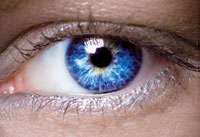Staying Fit


Maybe you're having a hard time reading this article. Or perhaps you have stopped driving at night because you just can't see as well then. Don't worry: Chances are, you're not going blind. But you might be experiencing some age-related eye issues.
Here's a list of the most common symptoms that affect your eyesight as you get older, why they happen, what to do about them — and when to see your eye doctor immediately.
1. Fuzzier small print
Why it happens: As you age, your eye's lens becomes less flexible, which means it has a harder time changing its focal point from far to near. That makes it difficult to focus on close-up objects.


AARP Membership— $12 for your first year when you sign up for Automatic Renewal
Get instant access to members-only products and hundreds of discounts, a free second membership, and a subscription to AARP the Magazine.
How to Fix it: You know you can get reading glasses or bifocals, but sexier options include bifocal contacts, multifocal contacts, or monovision, where one eye is fitted with a contact lens to see distance and the other eye is fitted with a lens to see close up.
"Monovision is a great option for many, but not everyone's brain accepts it," says Nancy A. Tanchel, M.D., an ophthalmologist and owner of Liberty Laser Eye Center in Tysons Corner, Virginia. You're a good candidate for bifocal, multifocal, or monovision contacts if you're willing to trade off supersharp vision at a distance for better close-up vision.
Red Flag: An abrupt decline in vision could be associated with several conditions, including macular degeneration, a disorder in which central vision is damaged; a vitreous hemorrhage, sometimes from an aneurysm in the eye, often associated with diabetes; or a retinal detachment. "Any abrupt change warrants an immediate evaluation," Tanchel says.
Next: Do you have dry or watery eyes? »
2. Dry eyes
Why it happens: When you're young, your tears have the right components to coat the eye completely. As you get older, your tears may lose their ability to fully lubricate the eye.
"Tears have three layers: a protein layer, a fat layer, and a water layer," says Tanchel. "If any of those layers are not working as well as they should, we call that dry eye."
Eyes may feel dry and scratchy, or they may water excessively to compensate for a tear imbalance. Blood pressure medicines, antihistamines, diuretics, hormone replacement therapy, and some antidepressants could be to blame, as could the use of a ceiling fan.

































































More From AARP
The 10 Best Superfoods for Your Eyes
Protect your vision with these nutritious (and delicious) foods